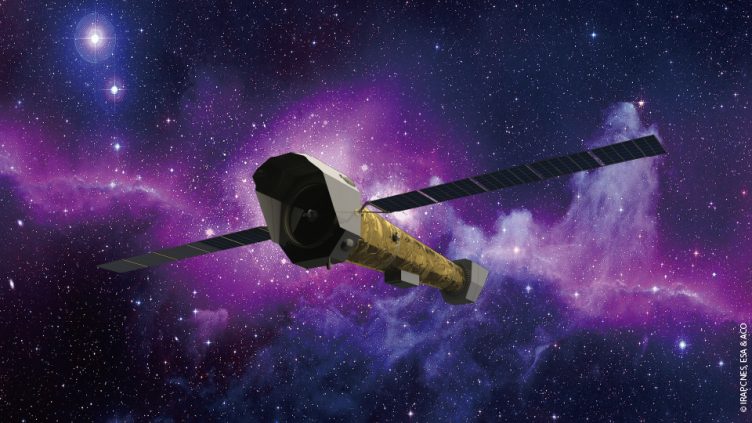Coordination:
The WFI is developed by an international consortium composed of ESA member states and led by the Max Planck Institute for extraterrestrial Physics (DE). The partners comprehend ECAP &IAA Tübingen (DE), University Vienna (AUT), DTU (Denmark), CEA Saclay & Strasbourg Observatory (FR), INAF Bologna/Palermo (IT), SRC PAS & NCAC PAS (POL), University Leicester & Open University (UK), Penn State, Standford, MIT & SAO (USA), University Geneva (Switzerland), IA (PT), and Athens Observatory & University of Crete (GR).
The Principal Investigator: K. Nandra (MPE); Project Manager: N. Meidinger (MPE); Project Scientist: A. Rau (MPE); Lead System Engineer: M. Plattner (MPE).
The WFI Consortium Board is chaired by K. Nandra (DEU) and includes J. Afonso (POR), D. Burrows (US), A. Comastri (ITA), A. Decourchelle (FRA), I. Georgantopoulos (GRE), F. Kerschbaum (AUT), S. Paltani (SUI), K. Pedersen (DNK), M. Watson (GBR), and P. Zycki (POL)
The WFI Science Team is chaired by A. Rau (DEU) and includes J. Afonso (POR), J. Aird (GBR), A. Comastri (ITA), D. Eckert (SUI), A. Fabian (GBR), A. Georgagakis (GRE), M. Güdel (AUT), A. Hornschemeier (US), A. Merloni (DEU), D. della Monica Ferreira (DK), G. Pratt (FRA), T. Reiprich (DEU), A. Rozanska (POL), J. Sanders (DEU), M. Sasaki (DEU), and J. Wilms (DEU).
ATHENA, the Advanced Telescope for High Energy Astrophysics, is the next-generation X-ray observatory selected as the second large mission (L2) of ESA’s Cosmic Vision-programme and scheduled to launch in 2031 (Nandra+13). Athena will address the “The Hot and Energetic Universe” science theme with its two main science instruments: the Wide Field Imager (WFI, Meidinger+18) and the X-ray Integral Field Unit (X-IFU). The main scientific cases aimed by the Athena instruments fall mostly behind these two big questions:
- How do baryons assemble and form the large-scale structures in the Universe that we see today?
- And how do black holes grow and influence their surroundings?
With its unparalleled capabilities, Athena will be a truly transformational observatory which, operating in conjunction with other future large observatories across the electromagnetic spectrum available like ALMA, ELT, JWST & SKA (among many others), will bring an enormous advance in our knowledge of the energetic universe.
Why IA in ATHENA/WFI?
The birth of the first Supermassive Black Holes (SMBHs), their evolution, and their influence in galaxy formation have been some of the cornerstones of the research carried out by the galaxy evolution group at the IA. Particular emphasis has been given to pinpointing AGN activity up to the highest redshifts as traced by its characteristic emission in the radio and X-rays. In this regard, the Epoch of Reionization (EoR; z>6) marks a critical landmark in the history of our Universe. This epoch sees the shine of the first stars, the first galaxies, and the first accretion onto SMBHs while it witnessed the initial connection between these components driving their later evolution.
The sensitivities and areal coverages to be reached will increase by at least 10x the number of detected Active Galactic Nuclei both pushing their characterization to fainter luminosities and into the early stages of BH and galaxy formation (EoR).
IA participates in the ATHENA development since the very early stages of the Athena proposal and in particular to the definition of the scientific and technical requirements of the WFI camera. IA researchers contribute to WFI through the:
- WFI Board • WFI Science Team • Athena Science Study Team (ASST)
- WFI Science Working Groups • WFI Science Ground Segment
IA will also deliver hardware components for WFI in collaboration with the PT industry and lead the design of one critical system of the telescope. In fact, in 2020, IA won a contract with ESA for the development of a high-precision optical system to be used for the critical alignment of the spacecraft mirrors (2.5 meters wide) with respect to the two instruments onboard. The IA instrumentation team is leading a consortium with the participation of three external partners (2 of them Portuguese): FHP, Evoleo, and Thales Alenia Space.
IA is actively participating in the WFI simulations to help constrain the final capabilities of the instrument and the scientific goals to tackle. IA is working with our WFI collaborators on a new set of simulations based on the expectations from the cosmological models explored by our group. IA is also contributing to the Ground segment development of Athena/WFI.

